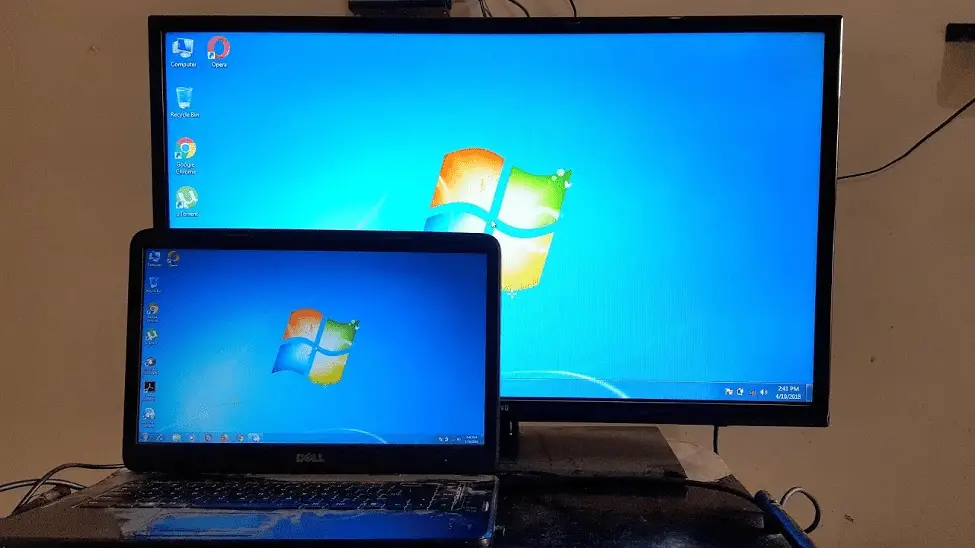I recently had a little tech adventure that I just couldn’t wait to share with you all.
If you’re like me and love streaming content on a big screen but don’t have an HDMI cable handy, fear not!
I’m going to walk you through how I successfully connected my laptop to a Samsung TV without using HDMI.
Prerequisites
A laptop: Any laptop will do as long as it supports wireless connectivity.
A Samsung Smart TV: It should be a relatively recent model with built-in Wi-Fi capabilities.
A Wi-Fi network: Make sure both your laptop and TV are connected to the same Wi-Fi network.
Method 1: Screen Mirroring (Windows)
If you’re a Windows user, Microsoft has got you covered with a nifty feature called “Project to this PC.” Here’s how to use it:
Press Windows + P: This will open the projection settings.
Select ‘Connect to a wireless display’: This will scan for available devices.
Choose your Samsung TV: Once your TV is detected, click on it to establish a connection.
Follow the on-screen instructions: You may need to enter a PIN displayed on your TV into your laptop.
That’s it! Your laptop screen should now be mirrored on your Samsung TV.
Method 2: Screen Mirroring (Mac)
If you’re an Apple aficionado like me, you can use AirPlay to mirror your Mac’s display on your Samsung TV. Here’s how it’s done:
Click the Apple menu and go to ‘System Preferences.’
Select ‘Displays’: Click on ‘Arrangement’ and then check ‘Mirror Displays.’
Click on the AirPlay icon in the menu bar.
Choose your Samsung TV: Click on it to start mirroring.
Now, your Mac screen is displayed on your TV wirelessly.
Method 3: Cast Your Browser (Chromecast or Miracast)
If you prefer using a browser to watch content, this method is for you. You can cast your browser window to your Samsung TV using Chromecast for Google Chrome or Miracast for Windows:
Install the Google Chrome browser if you don’t have it already.
Add the Google Cast extension: This will allow you to cast your browser tab to your TV.
Click the Google Cast icon in Chrome and choose your Samsung TV.
If you’re a Windows user, you can use Miracast:
Press Windows + P: Again, open the projection settings.
Select ‘Connect to a wireless display’: Choose your Samsung TV.
Follow the on-screen instructions: As before, you may need to enter a PIN.
Method 4: Use a Media Streaming Device
If none of the above methods work for you, you can always opt for a media streaming device. Popular options include the Amazon Fire TV Stick, Roku, or Apple TV.
These devices plug into your TV’s HDMI port and allow you to stream content from your laptop over Wi-Fi. This way, you can enjoy your favorite shows and movies on the big screen hassle-free.
Troubleshooting Common Issues
While connecting your laptop to a Samsung TV without HDMI is generally straightforward, you might encounter a few hiccups along the way. Here are some common issues and their solutions:
1. Connection Problems
Issue: Your laptop and TV can’t establish a connection.
Solution:
- Ensure both devices are connected to the same Wi-Fi network.
- Check if your TV’s firmware is up to date, as outdated software can cause connectivity issues.
- Restart both your laptop and TV and try connecting again.
2. Audio or Video Lag
Issue: You experience a delay between the audio and video on the TV.
Solution:
- Adjust the display settings on your laptop to match the TV’s native resolution.
- Make sure your Wi-Fi network is stable and not experiencing high latency.
- Restart your router to improve network performance.
3. Incompatible Laptop or TV
Issue: Your laptop or TV may not support the screen mirroring method you’re attempting.
Solution:
- Check your laptop’s documentation for compatibility with screen mirroring or casting.
- Ensure your Samsung TV is a Smart TV with Wi-Fi capabilities, as older models might not support these features.
Frequently Asked Questions (FAQs)
Q1: Can I use this method with any laptop and Samsung TV?
A1: It depends on the compatibility of your laptop and TV. Make sure your laptop supports the chosen screen mirroring method, and your TV is a Smart TV with Wi-Fi capabilities.
Q2: Is there a delay in audio or video when using screen mirroring?
A2: Sometimes, there can be a slight delay in audio or video. Adjusting display settings and ensuring a stable Wi-Fi connection can help minimize this lag.
Q3: Do I need an internet connection for screen mirroring?
A3: Yes, you need an internet connection for the initial setup and to stream online content. However, you can also cast or mirror local content without an internet connection.
Q4: Can I cast or mirror content from any app or website?
A4: Not all apps and websites support casting or screen mirroring. Popular platforms like YouTube, Netflix, and many browsers generally work well, but others may not be compatible.
Q5: What if my TV is not detected during the connection process?
A5: If your TV is not detected, ensure both devices are on the same Wi-Fi network, and check for firmware updates on your TV. Restarting both devices can also help.


